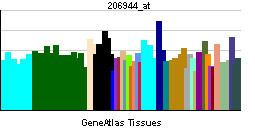Entrez 3362 | Ensembl ENSG00000158748 | |
 | ||
External IDs MGI: 1196627 HomoloGene: 673 GeneCards: HTR6 | ||
The 5-HT6 receptor is a subtype of 5-HT receptor that binds the endogenous neurotransmitter serotonin (5-hydroxytryptamine, 5-HT). It is a G protein-coupled receptor (GPCR) that is coupled to Gs and mediates excitatory neurotransmission. HTR6 denotes the human gene encoding for the receptor.
Contents
Distribution
The 5-HT6 receptor is expressed almost exclusively in the brain. It is distributed in various areas including, but not limited to, the olfactory tubercle, cerebral cortex (frontal and entorhinal regions), nucleus accumbens, striatum, caudate nucleus, hippocampus, and the molecular layer of the cerebellum. Based on its abundance in extrapyramidal, limbic, and cortical regions it can be suggested that the 5-HT6 receptor plays a role in functions like motor control, emotionality, cognition, and memory.
Function
Blockade of central 5-HT6 receptors has been shown to increase glutamatergic and cholinergic neurotransmission in various brain areas, whereas activation enhances GABAergic signaling in a widespread manner. Antagonism of 5-HT6 receptors also facilitates dopamine and norepinephrine release in the frontal cortex, while stimulation has the opposite effect.
As a drug target for antagonists
Despite the 5-HT6 receptor having a functionally excitatory action, it is largely co-localized with GABAergic neurons and therefore produces an overall inhibition of brain activity. In parallel with this, 5-HT6 antagonists improve cognition, learning, and memory, and agents such as latrepirdine, idalopirdine (Lu AE58054), and intepirdine (SB-742,457) are being developed as novel treatments for Alzheimer's disease and other forms of dementia.
5-HT6 antagonists have also been shown to reduce appetite and produce weight loss, and as a result, PRX-07034, BVT-5,182, and BVT-74,316 are being investigated for the treatment of obesity.
As a drug target for agonists
Recently, the 5-HT6 agonists WAY-181,187 and WAY-208,466 have been demonstrated to be active in rodent models of depression, anxiety, and obsessive-compulsive disorder (OCD), and such agents may be useful treatments for these conditions. Additionally, indirect 5-HT6 activation may play a role in the therapeutic benefits of serotonergic antidepressants like the selective serotonin reuptake inhibitors (SSRIs) and tricyclic antidepressants (TCAs).
Ligands
A large number of selective 5-HT6 ligands have now been developed.
Partial Agonists
Genetics
Polymorphisms in the HTR6 gene are associated with neuropsychiatric disorders. For example, an association between the C267T (rs1805054) polymorphism and Alzheimer's disease has been shown. Others have studied the polymorphism in relation to Parkinson's disease.
